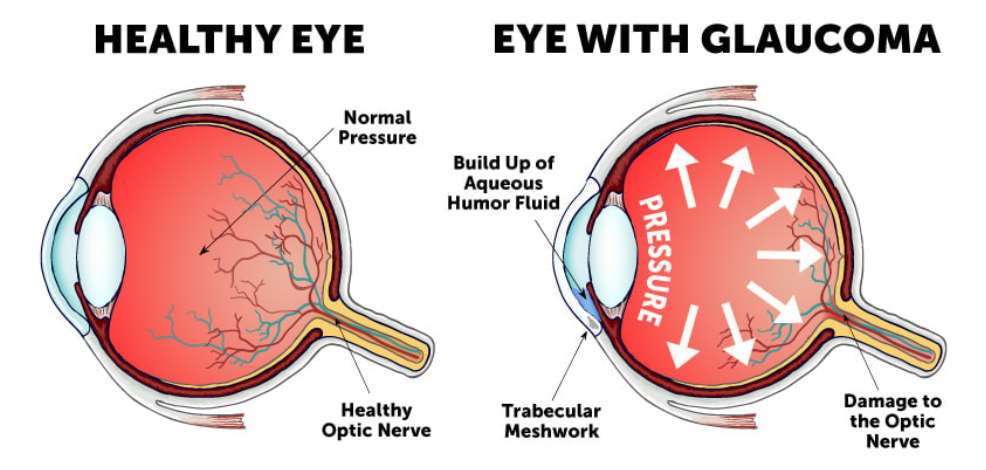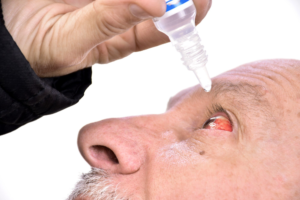
What is Glaucoma?
Glaucoma is a group of eye diseases that damage the optic nerve, often due to high intraocular pressure (IOP). It is one of the leading causes of blindness worldwide, but early detection and treatment can help preserve vision.
Types
1. Open-Angle Glaucoma (Most Common)
- Develops slowly over time
- Often no symptoms until vision loss occurs
- Caused by gradual clogging of the drainage canals
2. Angle-Closure Glaucoma
- Sudden increase in IOP
- Severe pain, nausea, and vision changes
- Requires emergency medical attention
3. Normal-Tension Glaucoma
- Optic nerve damage despite normal eye pressure
- Poor blood flow to the optic nerve may contribute
4. Congenital Glaucoma (Present at birth)
- Rare but serious condition in infants
- Caused by abnormal development of eye drainage
5. Secondary Glaucoma
- Caused by other conditions such as diabetes, trauma, or steroid use
- May result from underlying eye diseases
Causes & Risk Factors
Causes
- Increased intraocular pressure (IOP)
- Poor drainage of eye fluids
- Genetic mutations
- Autoimmune responses affecting the optic nerve
- Trauma to the eye
- Long-term use of corticosteroids
Risk Factors
- Age (over 40 years old)
- Family history of glaucoma
- High blood pressure & diabetes
- Thin corneas
- Prolonged steroid use
- History of eye injury
- Ethnicity (higher risk in African, Hispanic, and Asian populations)
- Migraine history
Explore a leading manufacturer of APIs.
With over 10 years of expertise, we ensure GMP compliance and provide reliable, high-quality solutions.
Symptoms
- Gradual loss of peripheral vision
- Blurred vision
- Eye pain & redness (in acute cases)
- Halos around lights
- Severe headache (in angle-closure glaucoma)
- Increased sensitivity to light
- Frequent changes in eyeglass prescription
- Tunnel vision in advanced stages
Diagnosis
Eye Exams & Tests
- Tonometry – Measures intraocular pressure
- Ophthalmoscopy – Examines the optic nerve
- Perimetry (Visual Field Test) – Detects vision loss
- Gonioscopy – Evaluates the drainage angle of the eye
- Optical Coherence Tomography (OCT) – Assesses optic nerve damage
- Pachymetry – Measures corneal thickness
- Retinal Nerve Fiber Analysis – Evaluates nerve damage
Treatment Options
1. Medications (Eye Drops & Pills)
Medications help reduce intraocular pressure (IOP) by either decreasing fluid production or improving drainage.
Common Medications :
- Prostaglandin Analogs (Increase fluid outflow)
- Latanoprost
- Bimatoprost
- Travoprost
- Beta-Blockers (Reduce fluid production)
- Timolol
- Betaxolol
- Alpha Agonists (Reduce fluid production & increase drainage)
- Brimonidine
- Apraclonidine
- Carbonic Anhydrase Inhibitors (Decrease fluid production)
- Acetazolamide
- Dorzolamide
- Rho Kinase Inhibitors (Enhance fluid outflow)
- Netarsudil
- Combination Eye Drops
- Brimonidine + Timolol
- Dorzolamide + Timolol
Major Suppliers of Prostaglandin Analogs Active Ingredients Worldwide.
2. Laser Therapy
- Selective Laser Trabeculoplasty (SLT) – Helps improve fluid drainage
- Laser Peripheral Iridotomy (LPI) – Used for angle-closure glaucoma
- Cyclophotocoagulation – Reduces fluid production by targeting the ciliary body
3. Surgical Treatment
- Trabeculectomy – Creates a new drainage channel
- Drainage Implants (Shunts) – Small devices implanted to aid fluid drainage
- Minimally Invasive Glaucoma Surgery (MIGS) – Newer, less invasive options
- Canaloplasty – Improves the natural drainage system of the eye
Prevention & Lifestyle Tips
- Get regular eye exams (especially after age 40)
- Maintain a healthy diet rich in antioxidants (green leafy vegetables, fish, nuts)
- Exercise regularly to maintain eye health
- Avoid excessive caffeine (can increase eye pressure)
- Protect your eyes from UV rays & injuries
- Manage underlying health conditions (diabetes, hypertension)
- Stay hydrated to maintain optimal eye function
- Reduce screen time and practice eye exercises
Prognosis & Outlook
While glaucoma has no cure, early detection and consistent treatment can help prevent severe vision loss. Regular eye checkups and adherence to prescribed treatment are key to managing the disease effectively. Without treatment, glaucoma can lead to complete blindness.
Research & Advances in Glaucoma Treatment
Recent studies and technological advancements have led to new approaches in glaucoma treatment, including:
- Gene Therapy – Potentially modifying genes to prevent optic nerve damage
- Neuroprotection Drugs – Medications aimed at protecting nerve cells
- Artificial Intelligence (AI) – Enhancing early detection through retinal imaging
- Stem Cell Therapy – Investigating regenerative treatments for optic nerve repair
- Implantable Sensors – Monitoring IOP changes in real-time
Chemignition Laboratory is a globally trusted manufacturer and exporter of high-quality Prostaglandins Active Pharmaceutical Ingredients (APIs).
We specialize in ophthalmic APIs and provide complete documentation support including,
- GMP Certificate
- ISO 9001 Certificate
- COA
- MSDS
- Stability Data
- Impurity Profile
- Customized packaging
- Cold chain logistics
- Safe delivery of sensitive APIs
We proudly supply high-quality Active Pharmaceutical Ingredients (APIs) to pharmaceutical companies around the world.
Partner with Chemignition Laboratory for consistent quality, regulatory compliance, and reliable global delivery.
Contact us at www.chemignition.com
Conclusion
Glaucoma is a silent but serious eye condition. Regular screenings, early diagnosis, and proper treatment can significantly reduce the risk of blindness. If you have risk factors or notice any symptoms, consult an ophthalmologist immediately.
Reference:
Cleveland Clinic (2024). Glaucoma: Symptoms, causes, types & treatment. https://my.clevelandclinic.org/health/diseases/4212-glaucoma
Mayo Clinic (2022). Mayo Foundation for Medical Education and Research. Glaucoma. https://www.mayoclinic.org/diseases-conditions/glaucoma/symptoms-causes/syc-20372839
Wolf Eye Clinic. https://www.wolfeeyeclinic.com/filesimages/Glaucoma/GlaucomaEyeDiagram-min-min.jpg
FAQs
What is glaucoma?
Glaucoma is a group of eye diseases that damage the optic nerve, often due to increased pressure in the eye. If untreated, it can lead to vision loss or blindness.
How is open-angle glaucoma different from angle-closure glaucoma?
Open-angle glaucoma develops gradually, while angle-closure glaucoma happens suddenly and requires immediate medical attention.
Manufacturer of Bimatoprost and Latanoprost?
Chemignition Laboratory is manufacturer of Bimatoprost and Latanoprost.
What happens if I stop using my glaucoma medications?
Stopping medication can cause a dangerous rise in eye pressure and increase the risk of vision loss.
What causes glaucoma?
The main cause is increased intraocular pressure (IOP), but factors like genetics, age, and certain medical conditions can also contribute.



